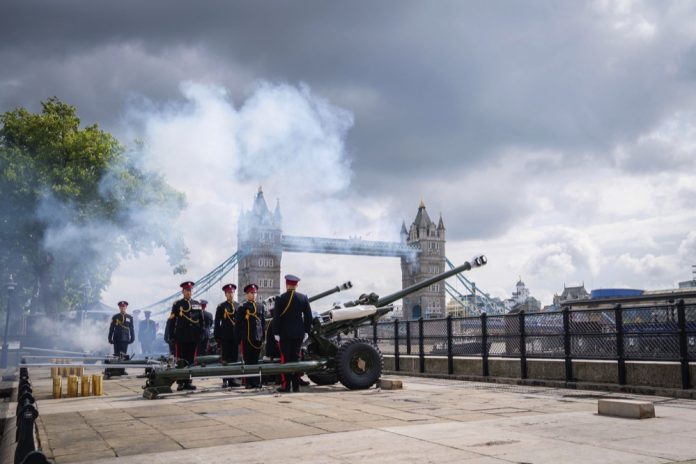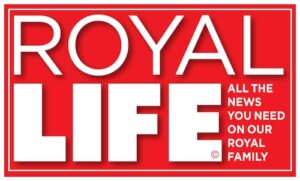
The King’s Coronation: Gun salutes
At 12:01 pm on Coronation Day, at the exact moment the St Edward’s Crown is placed on The King’s head, a six-gun salvo will be fired on Horse Guards Parade, and gun salutes will be fired at saluting stations across the UK, in overseas territories, and on His Majesty’s ships at sea.
But what’s the significance of these salutes, where will they take place, who will fire the guns and why will a different number of rounds be fired depending on the location?
Gun salutes have existed for centuries as a sign of respect or welcome, both on land and at sea, marking special occasions or military honours.
The tradition dates from the 15th Century when ships visiting foreign ports would discharge all their guns out to sea on arrival to show they came in peace.
British ships carried seven guns so seven shots became the standard to signal that the ship was now unarmed. The guns onshore would welcome the incoming ships by firing three rounds for every shot fired from the ships – putting the total number of shots fired at 21. This explains the 21-gun salute, the most common number of gun salutes used today.
A traditional Royal Salute comprises 21 rounds with an additional 20 rounds fired in royal parks, such as Hyde Park.
In 1946 King George VI instructed the War Office to form a horsed battery to carry out the ceremonial salutes in London and so the Riding Troop Royal Horse Artillery was formed. In 1947 the King, whilst visiting the Troop, renamed it The King’s Troop RHA.
Horse Guards Parade – A six-gun salvo, where all six Guns fire once at the same time, will be fired by The King’s Troop Royal Horse Artillery (KTRHA) at the precise moment His Majesty is crowned King. This mounted unit fires Gun Salutes to mark the grand occasions of State, including royal anniversaries, State Visits, and the State Opening of Parliament.
This six-gun salvo is a unique salute for the Coronation designed for maximum impact and to create a sound that will be clearly heard within Westminster Abbey.
71 horses will ride out on to Horse Guards Parade, of which 36 will pull six First World War-era 13-pounder Field Guns. The six guns will be positioned ten metres apart, in front of the Horse Guards Building and will face towards Buckingham Palace.
There are only ten such quick-fire howitzer guns still in existence. All the guns saw active service in both the First World War, where they were drawn through the mud-ridden fields of France, and the Second World War, when they were prepared as anti-aircraft guns.
Each gun is maintained by a limber gunner to an exacting standard. This is a significant challenge given there is no published maintenance manual nor spare parts. It takes approximately 100 hours to prepare each gun for state occasions.
King’s Troop soldiers have a vital operational role. They are trained as fighting soldiers first and foremost and when the Army deploys on operations the KTRHA provides drivers who deliver ammunition to artillery units around the battlefield. They are the most diverse and representative of any unit in the British Army, with a 50/50 male/female demographic.
Tower of London – On the anniversary of the Birth, Accession or Coronation of the Sovereign, 62 guns are fired from the Tower of London. This is made up of the Royal Salute comprising the traditional 21 rounds, a further 21 rounds to show the loyalty of the City of London to the Crown, and a final 20 rounds as the Tower is a royal palace and fortress.
Historically, every king needed the support of the City of London to hold their throne. Without the loyalty of its citizens to the monarch, ancient kings could not control the country. Even today, the King still needs the permission of the Lord Mayor of London to enter the square mile City of London.
A (1st City of London) Battery, Honourable Artillery Company will fire the 62 round Royal Salute from the Tower of London. This Army unit is a 105mm Light Gun battery that provides a reserve to 7th Parachute Regiment Royal Horse Artillery.
The Guns fired at the Tower of London will be three L118 105mm ceremonial Light Guns, converted from Guns that previously saw action during the Falklands conflict.
Battery Commander Major Matt Aldridge will have overall command of the salute, giving the fire orders, controlling the guns, and maintaining a rate of fire of ten seconds between rounds.
The Coronation gun salute of 21 rounds will be fired, with each gun firing at ten second intervals, at all Saluting Stations in the UK and Gibraltar, except for the Tower of London’s 62 round Royal Salute. These are the Army Saluting Stations across the UK:
Scotland, Edinburgh Castle – 105th Regiment Royal Artillery (Scottish and Ulster Gunners) (105 RA), a Close Support Light Gun Regiment, part of the Army Reserve, will fire the gun salute. Since their formation, which can be traced back to around 1859, 105 RA have deployed on or supported nearly every theatre of operation, from the First and Second World Wars, through to Iraq and Afghanistan and most recently Operation Cabrit in Estonia.
Scotland, Stirling Castle – The gun salute will be fired by troops from 53 Battery, 5th Regiment Royal Artillery. This Battery participated in Coronation parades in Dusseldorf in 1953 for the Coronation of Her Majesty Queen Elizabeth II as part of the British Army of the Rhine commemorations and in Delhi in 1903 for the Delhi Durbar for the Coronation of His Majesty King Edward VII. Troops from 53 Battery at Stirling Castle will be wearing the Maroon Beret with Number One Dress which signifies service with 16 Air Assault Brigade.
Before the union with England, Stirling Castle was a Scottish royal residence, a palace as well as a fortress. Several Scottish Kings and Queens were crowned at Stirling, including Mary, Queen of Scots in 1542, and others were born or died there.
Wales, Cardiff Castle – The gun salute will be fired by 104th Regiment Royal Artillery, an Army Reserve unit located across South Wales, southwest England and the West Midlands. The unit is equipped with the 105mm Light Gun and carries out all gun salutes in Wales, most recently to mark the passing of the Duke of Edinburgh and Her Majesty Queen Elizabeth II.
Cardiff Castle remains the principal saluting station in Wales, but events have also taken place in Cardiff Bay, at Alexandra Gardens in Cardiff, as well as at Caernarfon Castle in North Wales. The Regimental Band and Corps of Drums of The Royal Welsh and The Band of The Prince of Wales regularly play at these events, with The Goat Major and Lance Corporal Shenkin IV, the Regimental Goat of 3rd Battalion The Royal Welsh, and The Farrior Major and Lance Corporal Emrys Forlan Jones, a Welsh mountain pony from 1st The Queen’s Dragoon Guards (The Welsh Cavalry), also being regular attendees.
Northern Ireland, Belfast, Hillsborough Castle – 206 (Ulster) Battery, 105th Regiment Royal Artillery (The Scottish and Ulster Gunners) will fire the gun salute. 105 Regiment Royal Artillery is closely attached to 4th Regiment Royal Artillery, their regular army counterparts, with whom they provide Artillery support as part of 7th Light Mechanised Brigade, also known as The Desert Rats.
206 (Ulster) Battery Royal Artillery also have a ceremonial duty to fulfil and are tasked to carry out Royal Salutes throughout the year. The Battery fired a 96 round Royal Salute to commemorate the passing of HM Queen Elizabeth II as well as 21 round Royal Salutes for the national and regional proclamations of King Charles III and the arrival of King Charles III in Northern Ireland, where each member of the Saluting Troop was honoured to meet the King.
Colchester, Castle Park – The gun salute will be fired by 7th Parachute Regiment Royal Horse Artillery (7 Para RHA) – known as the Airborne Gunners – who are based at Merville Barracks, Colchester and equipped with L118 105mm Light Guns. The unit’s role is to provide joint fires to 16 Air Assault Brigade Combat Team, the British Army’s global response force, which is held at very high readiness to deploy anywhere in the world.
Stonehenge – The gun salute at this ancient site will be carried out by 14 Regiment Royal Artillery, the training support regiment of the Royal School of Artillery which prepares new Gunners for their initial regimental role. Stonehenge stood at the heart of the world’s largest military camp during the First World War. One million men trained for war there between 1914 and 1918, coming from across the Commonwealth.
York, Museum Gardens – The salute will be fired by 4th Regiment Royal Artillery (the North East Gunners), a close support artillery regiment armed with the L118 Light Gun, a 105mm artillery piece. The regiment normally provides fire support to light role infantry brigades (ones not mounted in the Warrior Infantry Fighting Vehicle) but has also deployed outside this role, such as in Northern Ireland, or more recently as part of the United Nations peacekeeping force on Op Tosca in Cyprus.
Plymouth, Royal Citadel – 29 Commando Regiment Royal Artillery will fire the salute with a 105mm Light Gun, the artillery gun used by the Regiment. A regiment of Commando Gunners held at very high readiness, these soldiers specialise in amphibious operations, mountain, desert, jungle and arctic warfare.
There will also be a Saluting Station at MOD Gibraltar, located at His Majesty’s Naval Base, at the end of Queensway Quay. The salute will be fired by Headquarters Company (Thomson’s Battery) Royal Gibraltar Regiment (RG).
This RG, known as The Barbarians, was formed in 1958, with the specific Battery named in honour of the late Sir Willie Thomson OBE, JP. After firing the 21-round salvo, the Inspecting Officer, Commodore Tom Guy, Commander British Forces Gibraltar, will be accompanied into the Tower by Lieutenant Colonel Matthew Moore, Commanding Officer of the RG.









